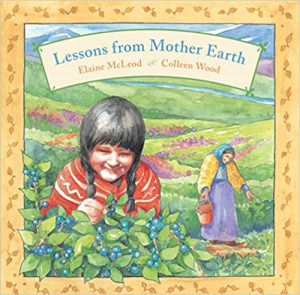Environment

Author(s): Elaine McLeod & Colleen Wood
Links:
Amazon: https://amzn.to/2WmPWEw
Indigo: https://bit.ly/2W4L7Ri
Social Justice focus: Environmental Stewardship
Synopsis: Lessons from Mother Earth is a story about a young girl named Tess and her grandmother. While Tess visited her grandmother often, she didn’t really have much knowledge about her grandmother’s garden. But, her grandmother felt like Tess was old enough to see this garden and learn about how to take care of it. Tess and her grandmother had to go on a long walk throughout nature in order to get to the garden, where she learns that all of nature can be a garden. Her grandmother shares with her how to take care of all the plants that are growing. She teaches Tess that it is important to know when each plant is ready and when they should be left alone, as well as how much of it to take when it is ready, without having taken too much and letting it go to waste. The plants will continue to nourish you for as long as you take care of the garden.
Lesson Plan: Daniela Presutto
Primary/Junior/Intermediate Lesson Plan (Abbreviated Template)
Consecutive and Concurrent Programs
Unit/Topic: Reflective Writing on a Social Justice Issue
Grade: 4
Minds-on: 6 minutes
Task: What will I be doing? What will students be doing?
- Read the short story, Lessons from Mother Earth – Elaine McLeod & Colleen Wood
Assessment: What is the Nature and Purpose of assessment?
- Assessment for learning: check list that will assess whether or not students understood the message that the short story was portraying.
Action: 12 minutes
Task: What will I be doing? What will students be doing?
- Students will be shown a series of powerful environmental images, demonstrating the reality of how the environment is being treated through various human-based actions and its consequences.
- Pictures shown in the following Google Slides link:
- https://docs.google.com/presentation/d/1Zz-xSPYws9r4db4OPHeqtm6BNSR5WJPZuIcmv6HI-FE/edit?usp=sharing
- Create a discussion with the class about the message of the story and how our actions correspond to the consequences that they see through these images.
- Ask students for their thoughts and feelings about what has been shared. Use prompting questions and guide the discussion to ensure that students are actively contributing to the discussion.
Assessment: What is the Nature and Purpose of assessment?
- Assessment as learning: anecdotal notes through conducting a discussion with students about the images they see and the connections they can make with the message from the short story to the real world.
Consolidation: 22 minutes
Task: What will I be doing? What will students be doing?
- Students will be required to write a 1 – 2 page reflection about what was discussed and their perspective on the matter. They may include their contribution to the wellness of our planet, what they do or what they can do to help, as well as reflecting on how our actions as humans have an impact on our planet.
Questions to consider…
- How has the condition of our environment gotten worse over time? What were the influences?
- What are current consequences that exist in our environment based on the actions of humans?
- What can be long-term impacts that will result from these ongoing issues in our future?
- What actions can we make in order to make a change and help our planet?
- What direct impacts/events can you think about that have or are currently occurring globally?
Assessment: What is the Nature and Purpose of assessment?
- Assessment as learning: rating scale would be used to assess how deep each student went into their reflection and the amount of points and critical thinking was used throughout their writing.

